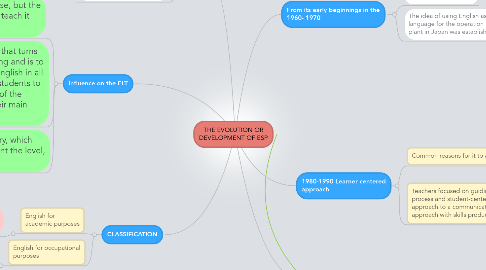THE EVOLUTION OR DEVELOPMENT OF ESP
作者:YOLEVANNY MORA ORTEGA


1. 1945
1.1. The end of the Second World War generated a demand for the mastery of an international language
2. Influence on the ELT
2.1. ESP is used for a particular purpose, but the techniques and methods used to teach it may be the same as in ELT.
2.2. There is a combination that turns out to be very motivating and is to apply the teaching of English in all subjects, which allows students to apply their knowledge of the second language in their main field of study.
2.3. Influences the choice of vocabulary, which should be done taking into account the level, proficiency, and role.
3. CLASSIFICATION
3.1. English for academic purposes
3.1.1. Relates to the English needed in an educational context
3.2. English for occupational purposes
3.2.1. Relates to professional purposes
4. 1980-1990 Learner centered approach
4.1. Common reasons for it to arise
4.1.1. Demands of a Brave New World
4.2. Teachers focused on guiding the process and student-centered approach to a communicative approach with skills production
4.2.1. Revolution in linguistics
4.2.2. Focus on the learner
5. From its early beginnings in the 1960- 1970
5.1. Product basic approach
5.2. The idea of using English as a common language for the operation of the power plant in Japan was established.
6. WHAT IS ESP? 1990-2000
6.1. is an approach to language teaching
6.1.1. In which all decisions as to content and method are based on the learners reason for learning.
